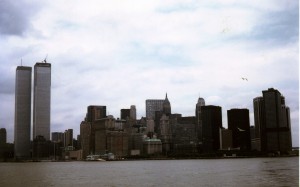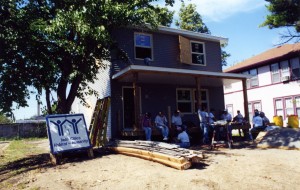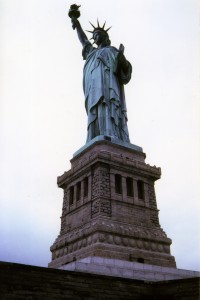UPDATE September 12, 2011: There have been a large number of comments on this post. They are in a separate post for September 11, 2011, here. Additional comments will be added to this post, as received.
September 9, 2011
Dear Family and Friends:
One of the indelible memories of my life came on my 60th birthday, May 4, 2000. We spent the entire day at the horrific Auschwitz-Birkenau death camp in Poland. Entering one of the first buildings with the awful artifacts of the final solution – hair, shoes, suitcases… – was a sign with this quotation:
“Those who
cannot remember the past,
are condemned to repeat it.”
George Santayana
We Americans – every one of us – have created what became the ten years after 9-11. We are well advised to remember Santayana’s admonition as our future begins with President Obama’s address to Congress a few hours ago.
Everyone has their own perspective.
Here’s how I remember the last ten years, and how I hope we work for a better future.
*
Here are two snapshots I took of the as-yet incomplete twin towers of the World Trade Center 39 years ago, in late June, 1972. (click to enlarge). (The Statue of Liberty photos later in this post were taken the same day.) This was my first and to date only visit to New York City. I remember the day vividly.

Twin Towers nearing completion late June, 1972 (see construction equipment on top of one of the towers)

New York City skyline from ferry enroute to Statue of Liberty late June, 1972
I also remember vividly 9-11-01: The
death toll that day was approximately 3,000. Each of those people died tragically and needlessly. This doesn’t make them unusual. Thousands of others die tragically and needlessly every day, everywhere. How we have elected to hang onto the circumstances of the death of these 3000, and what it has done to us as a nation, is what makes this ten year commemoration unusual. (See NOTE FROM MADELINE SIMON at the end of this post).
The ten years since 9-11-01 are ten years we should all also remember vividly:
– We’ve been in two wars, now ten years old, with no end in sight;
the price of 9-11 has been dreadful;
over 100,000 dead in Iraq,
25,000 in Afghanistan; – hundreds of thousands of people displaced; plenty of anger against the United States by these people;
–
over 6,000 U.S. dead in these wars;
– Over 3 trillion of our dollars ($3,000,000,000,000) spent, not counting huge and certain future costs even if the wars were to stop today;
– incalculable ruin to our national reputation – a reservoir of ill-will which will not be forgotten.
And the War continues….
In my opinion it need not have been this way:
Here’s my personal recollection written a few days after 9-11: September 17 and 24, 2001, a letter to family and friends reflecting on 9-11-01. (Entire letter here
Post 9-11-01001.)
9-11-01 was my second day on the job as a volunteer on a
Habitat for Humanity house in south Minneapolis. A large crew of us from Basilica of St. Mary in Minneapolis volunteered for one or more days during our two week commitment. Per previous plans, Cathy, my wife, and son-in-law John also joined that crew the week of 9-11. I was there the first week.

Habitat Home Stevens Ave S Minneapolis MN Sep 11, 2001
After 9-11 we were overrun with unexpected volunteers coming off the street to help – their way of dealing with grief, I suppose.
This urge to do something positive was a very normal immediate outcome of the shock of 9-11, as it is a normal response after any tragedy.
For many years I have kept a handout from a long-ago workshop I attended which explains the normal human response to crisis very well (click to enlarge). Note: the time period to recovery is described in months, not years:
 OUR RESPONSE POST-9-11-01
Rather than normal and positive resolution of grief, and closure, after 9-11-01 we in the U.S. chose to go to war. It was and is a disastrous decision.
OUR RESPONSE POST-9-11-01
Rather than normal and positive resolution of grief, and closure, after 9-11-01 we in the U.S. chose to go to war. It was and is a disastrous decision.
We Americans* almost unanimously supported war as a remedy. Afghanistan Oct 7 2001001
One wonders what would have happened had we chosen to respond as Norway did in the wake of their July 22, 2011, terrorist attack.
After 9-11 we were largely kept in the dark about specifics of war plans. Five months after 9-11, a
column (2002001) I wrote for the Minneapolis Star Tribune (published April 20, 2002),
does not even mention the word “Iraq”. Iraq was not on my radar screen then, and I was an engaged citizen then.
In April, 2002, the official roll-out of the Iraq War was nearly a year away.
But we now know the Bush administration focus had almost instantly shifted to Iraq after 9-11,
even though Iraq, and no Iraqis, were involved in 9-11. We took the deadly fork in the national road which we still live with today.
At the same time we launched this war, we were
encouraged to get on with life, to go shopping, and we happily obliged during the decade. Vice-President Richard Cheney famously noted that
“deficits don’t matter….” (see 18th para beginning “In his own account…”).
War almost instantly became an opportunity to implement the dreams of the
Project for a New American Century. Its principles are worth rereading, as are the names of its signatories. Most of its signatories likely still believe its false premise: America once and forever King of the World. Too many of us still have visions of a permanent American empire. (My opinion: We could not effectively conquer Iraq, a place similar in size and population to California. Our vision of world dominance was false then, and still is. It is rapidly killing us.)
In October, 2002, Congress issued what turned out to be a
blank check to wage war on the national credit card. (You can see how the political parties voted on that resolution in 2002 at the preceding link.)
We, the people approved that action; indeed, it can fairly be said that we insisted on war. It was politically very dangerous for a politician to be against this War on “terrorists”. We the people bought the idea of war, and thus we own its consequences.
We’re still at war in Afghanistan, the place we attacked first, 10 years ago. Much of our national debt flows from war, not only unpaid for by any national sacrifice when it happened, but accompanied by huge and continuing tax cuts for everybody; and unfunded, large and politically popular Medicare improvements. To this day, we refuse to pay for that credit card debt of ours. As a nation we are still very deep in denial.
We effectively demand even more tax cuts and to slash our government (our state and national infrastructure) even further, rather than using our still great national wealth to work on reducing our debt. Going broke is a deliberate political strategy of the many current government leaders who follow Grover Norquist, whose
anti-tax mantra has long been to starve government “until it can be drowned in the bathtub”. There is no negotiating with such an ideology.
We didn’t know it 9-11-01, but 2001-2011 became a highly radical Republican decade all the way up to the present moment where the avowed and very public aim of the Republican leadership is to make certain that President Obama fails to generate jobs for national recovery. “Give us another chance”, they seem to say. “See him fail.” The same characters in charge will bring the same results as in the past, I say. Watch their real response to the Presidents request last night over the next months to discern their priorities.
The Republican leadership of the last 20 or so years is not cut from the same Republican cloth as my father’s or grandfather’s generation, nor my own. The current Republican leadership bunch worships power and control for its own sake. (For a dozen years my own political “best friend” was a former Republican Governor until he passed away several years ago. He would not be welcome in today’s Republican party.)
Today’s Republican strategy is led by amoral radicals** whose sole interest is permanent majority and raw power, rather than the long-term health of this country.
Ten years after 9-11, we’re still at it even though, for all intents and purposes, our country went bankrupt “going shopping” for everything we desired, getting big tax breaks and unpaid for benefit increases, and making war on credit***.
Now the narrative that I hear from the political radical right about our current national malaise is: “It’s all Obama’s fault, just give us another chance….”
This is insane.
So, what does this all mean? I removed from the title of this post these words: “A squandered decade.” But that is exactly what 2001-2011 has been: a squandered decade. And we continue the waste.
When will we Americans get a grip on reality?
Ten years ago we were caught unawares, and our emotions were easily manipulated and used.
Will the coming ten years be more of the same?
We are still “going shopping”.
Ten years from now, where will we be?
Are we going to continue down the same destructive road which has all but destroyed us; or will we commit to positive change? It is we citizens who will decide the future of our children and the generations to follow.
It is we as individuals who will be determining the answer to that question.

Same former Habitat house in South Minneapolis Sep 11, 2010. It continues to look the same in September, 2011, and to my knowledge remains occupied by the same Somali family for whom it was built ten years ago.

Statue of Liberty New York City harbor late June, 1972

Joni and Tom Bernard at Statue of Liberty, late June, 1972
received on August 8 prior to publication of this post, and included with her permission. Madeline is a long-time good friend, very active in Justice and social concerns issues with her Church. I met her through my involvement with the Minnesota Alliance of Peacemakers. She sent this item to persons she knows:
Last night, I happened to catch part of [PBS] Frontline, titled “Faith and Doubt at Ground Zero.” [NOTE: this is can be watched online
here] Representatives, particularly clergy, from the three major religions all talked about the very real, scary dark side of religious zeal, equally lethal in their respective religions. One, who shared the podium at a 9/11 memorial service with clergy from other religious traditions became the receiver of hate mail from members of his own clergy. They were incensed that he would give any degree of validity to another religion and its followers, and he was asked to resign as a minister of their absolute truth faith.
One woman related that in an interview with Putin, he said that to the 9/11 hijackers, the people in the towers were “just dust.” In the Nazi era, Jews were considered less than human by some supposed Christians; in the U.S. pre-civil rights era, some Christians considered blacks less than human; and some Israeli Jews treat Palestinians similarly. Much evil has been done throughout history in the name of God, and it continues today.
No doubt that the extreme religious right in our country is dangerous, used and exceedingly well-funded by greedy corporate America who demand laissez faire–no government-by-the-people regulation of their excesses, and they should not be allowed to control government at any level. Our government, federal and local, are already dysfunctional, preferring to be insanely destructive rather than lose power in the interest of the common good.
We have much important work to do before the next election, none being so important as reminding the country of our common humanity, the inherent worth and dignity of every person, and our interdependence, on each other and the well-being of our small planet. As Unitarian Universalists and a 501(c)(3) religious organization, we can’t advocate for or against candidates, but issues are fair game!!!
FOOTNOTES:
* – This commentary is written to “we, the people”. We are a society that likes to blame somebody else for our problems. The collective credit or blame lies with everyone of us, so long as we are fortunate enough to have a democracy (that is at risk).
** – “ends justify the means, politics is war, winning is all that matters” seems the dominant ethic. It is amazing, and very discouraging, to see the kind of racist, false and malicious information that is passed along, computer to computer, these days. Media advertising is as bad. It is far worse on the Republican side than on the Democrat. A recently retired 30-year GOP staff member in Washington recently wrote very candidly about this problem. You can read it
here.
*** – even considering today’s relatively high unemployment, America is an immensely wealthy nation with far more than sufficient resources to recover from a problem we never should have gotten into. But to do so requires our political will, and the congressional leadership feels the problem is more beneficial to their interests than a solution.
There are many directly related posts, if you wish, beginning with June 27, 2011:
I will write a followup to this post, most likely on Monday, September 12, 2011
June 27, 2011: Killing the President, and many posts in the weeks that followed.
July 23, 2009: International Peace Garden













